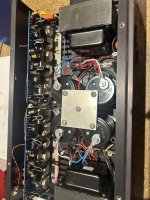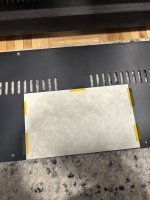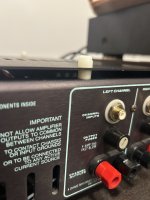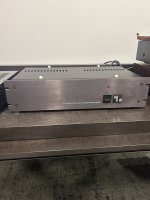Kapton is mechanically poor, and rather fragile and easily torn or punctured.
Also Kapton tape does not stick very well at all.
Nomex and Garolite are almost impervious, even in thin sheets. No need to fasten them to the cover.
Instead, attach the material to the top of the copper bus, cut large enough to extend over all sides.
Just two or three nylon screws should do it.
Also Kapton tape does not stick very well at all.
Nomex and Garolite are almost impervious, even in thin sheets. No need to fasten them to the cover.
Instead, attach the material to the top of the copper bus, cut large enough to extend over all sides.
Just two or three nylon screws should do it.
Got back from a nice break and decided to pick up the project. Using the JBL N26s as sacrificial speakers, I ran it through a few paces before moving up. I plan to use some non-corrosive rtv to secure one end of the capacitor clamp hardware and the nomex (experimenting now). The ESR and capacitance of the tantalum caps still measured better than the replacement Nichicons (using multi and ESR70) Everything seems functional and sounds great (I dont have a scope and my knowledge on the topic is limited) except two points…
First, the DC offset between the speaker terminals is 40.3 mv on the left and 53.5 on the right. Im thinking I should try to get this lower. There is a single potentiometer on each channel board, unsure if this is for the DC balance or if it was for biasing. If anyone with experience can chime in on this it would be much appreciated!
Second, ground loop is quite loud. This is removed when the amp is disconnected from the equipment and I assume will become less of a nuisance once problem #1 is fixed.
Thanks to all who have helped me along the way!




First, the DC offset between the speaker terminals is 40.3 mv on the left and 53.5 on the right. Im thinking I should try to get this lower. There is a single potentiometer on each channel board, unsure if this is for the DC balance or if it was for biasing. If anyone with experience can chime in on this it would be much appreciated!
Second, ground loop is quite loud. This is removed when the amp is disconnected from the equipment and I assume will become less of a nuisance once problem #1 is fixed.
Thanks to all who have helped me along the way!




Historically I have found the Tantalum caps to be not very reliable, so feel free to replace them.I would leave the Tants in as they have a better specification than most electrolytics.

I have not been in the repair business for long, a mere 50 years and I can count on two hands how many Tants I have had to change, usually because they are run at less than the specified voltage oddly enough. Checkout the chemical composition and you will see how the chemistry works.Historically I have found the Tantalum caps to be not very reliable, so feel free to replace them.

Electrolytics, on the other hand, remain countless as there were so many faulty/leaky caps and still are.
Usually power supply, stressed position main smoothing capacitors, together with low voltage (again) feedback capacitors.
Tants, nearly always, fail short circuit, so easy to test on the board.
Not so many polystyrene types but almost all paper in oil get leaky due to their age and the ingress of moisture from the atmosphere.
If a Tant is short circuit, a quality electrolytic will replace it but I always change like for like as the designers, unless a stock fault has been flagged up, usually know more than we do.
The designers don't choose expensive Tants instead of cheaper electrolytics for no reason.
up to 100mV of offset is practically safe industry standard
though, always better if less
if you have just one trimpot on board, it's certainly for Iq, so don't touch it if Iq is in prescribed bracket
though, always better if less
if you have just one trimpot on board, it's certainly for Iq, so don't touch it if Iq is in prescribed bracket
@Zen Mod , thanks for this insight 👍
Thank you all for getting me this far, it sounds wonderful and I accept that nothing can be perfect. I have taken this project as far as my skills allow and this journey has helped me realize that it is time for a modern amplifier… perhaps an ATC P1 or I will save for one of Mr. Pass’ creations 👍
Thank you all for getting me this far, it sounds wonderful and I accept that nothing can be perfect. I have taken this project as far as my skills allow and this journey has helped me realize that it is time for a modern amplifier… perhaps an ATC P1 or I will save for one of Mr. Pass’ creations 👍
I accept that nothing can be perfect.
quite contrary - nothing wrong with DC Offsets in your amp
considering and despite its age, you have it practically perfect
Could you let me know what the current rating is of the 2 internal power supply fuses? I picked up a CAS 1. Power supply caps were bad but the previous owner removed the blown fuses. My unit is 120 VAC.
Thanks,
Eric M.
Thanks,
Eric M.
Also wanted to share that I never got around to epoxying the nomex and noticed that the kapton tape had started to peel off.
Definitely a warning to anyone thinking of just using tape to protect you 👍
Definitely a warning to anyone thinking of just using tape to protect you 👍
Thank you! I appreciate the help. The previous owner had removed the output fuses to put in place of the internal fuse that kept blowing .... and then forgot what the rating was of the internal fuses! I'm guessing he used the output because they were the same rating so maybe we have it right, 4 amps.@Eric M
It’s a 4amp 3AG 250v fast blow, same as the output.
It is a littelfuse 312 series. They might not be original as my unit had low quality caps put in at some point.
Also, mine came with 5000 uF power supply caps. They seem original (one has shorted so I know if must be pretty old). Ther fit in the original holders and the metal plate screws to them justy fine. Do we know for sure if 5000 uF was not what the CA 1 came with? It seems odd that both yours and mine would be downgraded since the trend is to go up.
I did find a schematic here for the power supply but it was not original and did not match the wiring in my unit. Other than the fuse issue, mine does not seem to have been tampered with, it's probably a pretty good example of an original unit. It came from an estate sale (The liquidators were the ones that swapped the fuses).
Nice find!
Yes, from what I could find online they came with ~5-6.8k uf caps (if I remember correctly). Given the replacement values put into mine at some point, I assume I had 5k as well.
I may have gone overboard, but they play wonderfully. What values will you go with? Also curious if you will change out other caps.
Yes, from what I could find online they came with ~5-6.8k uf caps (if I remember correctly). Given the replacement values put into mine at some point, I assume I had 5k as well.
I may have gone overboard, but they play wonderfully. What values will you go with? Also curious if you will change out other caps.
I went with 8200 uF:
https://www.mouser.com/ProductDetai...DFHI%2BQPDQ==&countryCode=US¤cyCode=USD
I was worried about going too high.
This is for resale so just doing the power caps since one shorted - I've got about six 4000, maybe that many 400a, four SA1, a pair of S-1000 and a pair of SA 12e and a bizarre 400a w/ a 4000 faceplate, NP thought this might have been a one off for his wife? Too much Threshold! The CAS 1 was local, a good deal and it was broken which made it a fun project. I'll run it for about 8 hours and if it doesn't fail, it's going on e-Bay.
https://www.mouser.com/ProductDetai...DFHI%2BQPDQ==&countryCode=US¤cyCode=USD
I was worried about going too high.
This is for resale so just doing the power caps since one shorted - I've got about six 4000, maybe that many 400a, four SA1, a pair of S-1000 and a pair of SA 12e and a bizarre 400a w/ a 4000 faceplate, NP thought this might have been a one off for his wife? Too much Threshold! The CAS 1 was local, a good deal and it was broken which made it a fun project. I'll run it for about 8 hours and if it doesn't fail, it's going on e-Bay.
- Home
- Amplifiers
- Pass Labs
- Threshold CAS 1 - Trying to undo a previous “repair”